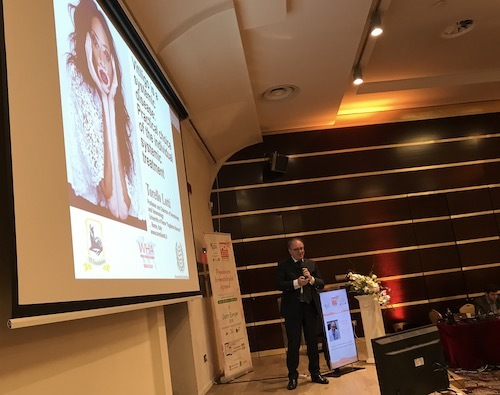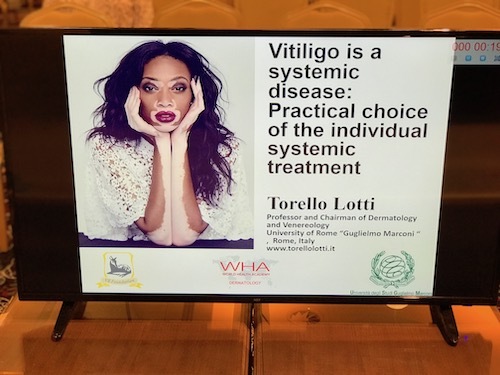New
New therapies for vitiligo are in the pipeline. How soon we'll see them in the clinic?
Newsletter April 2019.
Until about a decade ago, dermatologists believed that all vitiligo patients were created equal. And so they were treated that way because the arsenal of available weapons to fight them was woefully small.
The standard operating procedure was to typify vitiligo by what body part it affected and it’s shape. All dermatologigsts had to work with was either a phototherapy or (rarely) microsurgery, usually combined with topical treatments. That is still being done, though the vitiligo landscape is rapidly evolving.
The new drugs in the biopharma development pipeline can soon fundamentally change how dermatologists treat vitiligo patients.
At the vitiligo session held during a recent Iaşi Dermatological Spring congress, Prof. Torello Lotti reminded participants about a complex and systemic nature of vitiligo, or rather, - vitiligos. First, dermatologists have to diagnose a specific subtype of vitiligo based on its intrinsic properties, some yet have to be clarified. Next, check for underlying and overlapping conditions. Then, move away from the one-size-fits-all approach that characterised vitiligo therapies up until recently and make it more personalised, safe and effective treatment.
AND SO…
New treatments for autoimmune conditions, like vitiligo, rely on inactivating the 'crazy' immune cells that mistakenly identify and attack the body's own healthy cells. The outcomes of such treatments are far from being perfect, but benefits usually outweigh side-effects.
A modified HSP70i protein may be regarded as a good candidate for stopping rouge T-cells and thereby reversing an autoimmune process. Preclinical data obtained in mouse models support the trial of the mutant protein in humans. HSP70i-based therapy for vitiligo is now being developed by Temprian Therapeutics from Chicago. The company is seeking regulatory approval and venture funding for clinical trials.
Another promising drug candidate targets and removes the memory cells responsible for recurrent vitiligo. For example, a combination treatment with JAK inhibitors — such as tofacitinib — blocks interferon gamma signaling and helps in restoring the skin color. The problem is that the therapeutic effect is only temporary, and vitiligo usually reappears as soon patient stops using it. Dr. John Harris and colleagues from UMass in Boston have determined that autoimmune memory cells are responsible for vitiligo relapses, and found the way to remove resident T-cells from the skin. According to Dr. Harris, this may provide “long-lasting results typically not seen in dermatology.” Research has already turned from academia to biotech development phase.
Autoimmune therapies represent a great alternative to the old treatment paradigm, and may have fewer and milder side effects while being more effective. I know you’re waiting for the “but,” and of course there is one... or actually, three.
BUT...
- At the moment, the specific subsets of vitiligo patients that can be treated with these anti-autoimmune therapies aren’t clear — but they are certainly not all-inclusive. To treat the majority of patients with different forms of vitiligo, Big Pharma will have to develop a number of such drugs, with a mind-twisting cost in a billion dollar range.
- These drugs wouldn’t come cheap, and are unlikely to be a one-off treatment. I expect them to be in $10K+ per year range. The blood and other tests for anything vitiligo are not usually covered by insurance, adding to the bill.
- Lastly, there is an unknown cost of messing up with the immune system. A major downside of anti-autoimmune therapies is that they may end up inactivating not just the specific immune cells causing the damage, but also other immune cells that are functioning normally. However, a recently published research paper demonstrates the possibility of deactivating only rogue immune T-cells, while preserving normal immune cells so they can continue to do their job.
The bad news is that some of these drugs — if all goes well — will come to clinics no earlier than in mid 2020’s. The good news is that this new approach to vitiligo treatment is well on its way to becoming mainstream. And that’s huge.
Before you go: watch how a rising basketball star Devontae Shuler, Irmo native and Ole Miss guard, is dealing with vitiligo.
GALLERY

Prof. Torello Lotti. Vitiligo is a systemic disease: Practical choice of the individual systemic treatment.

Image: Winnie Harlow, a top fashion model with vitiligo.
FAQOther Questions
- How can I cure vitiligo?
Currently, there is no cure for vitiligo. However, many treatments can help manage the condition by restoring skin pigmentation, halting the progression of depigmentation, and i...
- Is vitiligo contagious?
Vitiligo is not contagious. This means it cannot be spread from person to person through physical contact, sharing personal items, or any other means of transmission. Vitiligo ...
- Is there a traditional medicine to treat vitiligo?
Traditional remedies can play a supportive role in managing chronic, metabolic, and stress-related conditions—particularly early in the disease process, before significant tissu...
Though it is not always easy to treat vitiligo, there is much to be gained by clearly understanding the diagnosis, the future implications, treatment options and their outcomes.
Many people deal with vitiligo while remaining in the public eye, maintaining a positive outlook, and having a successful career.
Copyright (C) Bodolóczki JúliaBy taking a little time to fill in the anonymous questionnaire, you can help researchers better understand and fight vitiligo.
